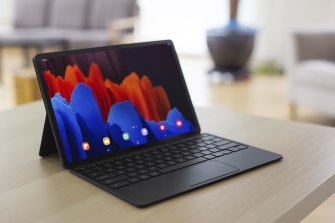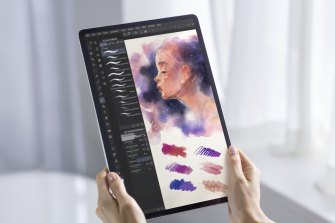
Android tablets are a dying breed, and the space is especially dire in Australia. Brands leading the category globally, including Amazon and Huawei, simply don’t offer their tablets here. Others, including Lenovo and Samsung, pick and choose which models to bring over. But that doesn’t necessarily mean Android isn’t worth considering if you’re after a big touchscreen device.
Apple’s iPad is the defacto choice for tablets, with the obvious alternative being a Microsoft Surface or similar Widows machine. To test out whether Android could hold its own I’ve been using Samsung’s Galaxy Tab S7+; a device specced as closely to the iPad Pro as the Korean electronics giant could manage. It’s a very impressive device that makes great use of Android 11, but it also demonstrates why tablets like this are increasingly hard to come by.

The Tab S7+ comes with a great stylus, but the keyboard is sold separately.
Starting at around $1500, the 12.4-inch Tab S7+ is pricey but stacks up well to the competition when it comes to the spec sheet. It’s a thin slate with an aluminium finish, a stunning 120Hz OLED screen, a stack of rear cameras (plus one forward-facing), quad speakers with Dolby Atmos and a very powerful octa-core processor inside. Despite all this you can run it non-stop for around eight hours thanks to a mammoth 10,090mAh battery, and it lasts days with conservative use.
Hardware-wise that all meets or exceeds the bigger iPad Pro, which starts at $1649, and in many ways it’s similar in actual use. The incredible screen, speakers and horsepower make it great for gaming and streaming video, and there are also a raft of ways to adapt it into a super-mobile work station.
You can pair wirelessly with a Samsung phone or any Windows PC, plug into a monitor and accessories to work like a desktop, or attach the (sold separately) keyboard cover to have the tablet become a little laptop.
The benefit of Android is in versatility and flexibility, and with some effort you can customise the experience beyond what’s possible with an iPad. But where Apple’s device is supported by a rich ecosystem of creativity-focused apps, and the iPhone-maker’s keen eye for curation and streamlining, the app ecosystem here leaves a lot to be desired.

Clip Paint Studio is a great app from the Galaxy Store, but it’s not up there with Adobe’s suite on iPad.
Samsung’s own apps are very slick and make excellent use of the included capacitive stylus, which can be magnetically docked at the top of the device or stored on the rear to charge. Google’s offerings of course are solid, and Samsung’s worked closely with Microsoft to ensure things like Office are smooth, and you can back up all your files to OneDrive.
But there’s a noticeable dearth of big names when it comes to things like photo or video editing, or really any creative work. The likes of Adobe publish very basic versions of their wares on Android, and there’s an ocean of unknowns to try, but it all feels underbaked compared to iPadOS. Because of the huge diversity of Android devices, and and the perceived or actual unwillingness of Android users to pay for things, premium productivity software is hard to come by.



























